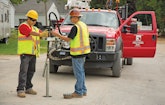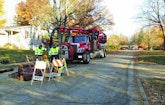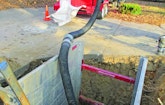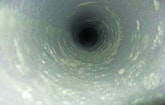
Interested in Inspection?
Get Inspection articles, news and videos right in your inbox! Sign up now.
Inspection + Get AlertsLike many utilities, the Public Works Department of the City of Moline, Ill., is investigating new technology to address old problems. In fall 2013, the utility took on the challenge of cleaning a tuberculated water main and lining it in a single day, with only a 12-hour interruption in water service. Its choice of technology: a one-two punch offering the first U.S. demonstration of the Tomahawk, an air-driven abrasives cleaning technology, followed closely by 3M Company’s Scotchkote Liner 2400.
Greg Swanson, utilities general manager with the City of Moline, has worked for the city since 1977. A self-described “old school” talent, he’s worked his way up the ladder on an enthusiasm for work and mechanical aptitude. Distribution manager Tony Loete has worked for the city since 1990, leveraging organizational skill to manage a growing portfolio of responsibilities that now includes customer service, metering and utility billing.
“We’re facing the same challenges across the country,” Swanson says. “We’re all stretching our skills and budgets to do more with less.”
The city is located near the Iowa-Illinois border, about halfway between Des Moines and Chicago. It’s bordered by the Mississippi River to the north and the Rock River to the south. The water system originated circa 1875 when sawmills in the area created a fire suppression system drawing water from the Mississippi and employing cast-iron mains. By the 1890s, a municipal water system developed in the area with water also drawn from the Mississippi.
“What’s interesting about our water treatment system is that we’ve employed lime softening since about 1950, which is somewhat unusual for surface water treatment,” Swanson says. “It reduces calcium and magnesium levels in finished water and enhances the performance of our clarifiers.”
The Mississippi can turn from drought to surplus in the space of a year. While conservation efforts have paid off, the city faces the typical conundrum posed by fixed costs and declining water consumption, with water rates climbing to cover lost revenue.
Pipes take punishment
The city’s water mains must withstand changes in temperature from 33 to 90 degrees F and, in order to transmit water from the lowest parts of the city, an initial water pressure of 110 psi is required to achieve a delivery pressure of 45 psi at the city’s highest elevations in the bluffs. While the system experiences an average of 35 water main breaks per year, the frigid weather of winter 2013 more than doubled that number.
“We’re asking a lot of our pipes,” says Loete. “While the oldest pipes in the distribution system are cast iron, it’s the thinner cast-iron pipes manufactured and installed following WWII that give us the greatest number of water main breaks. In the 1970s, the city moved from cast iron to ductile iron, which is the only type of pipe we install now. With an expected service life of 100 years, we believe ductile offers the best long-range value and lowest life cycle costs.”
The city is the home of John Deere, and the department is no stranger to the brand, with three Deere backhoes at its disposal and an equal number available from other city departments. On the wastewater side, Moline fields two Vactor jet/vac trucks, which perform double duty as hydroexcavators for the water department.
In-house crews handle most of the emergency repair work, while outside contractors handle larger replacement projects.
GIS mapping began in 2002, employing Esri ArcGIS software, and is now substantially complete following efforts by in-house staff and a series of interns assigned to the task.
“It’s one of our proudest achievements,” says Loete.
The utility conducts an in-house leak detection program employing an Itron DigiCorr digital leak noise correlator. A mechanic assigned to the task completes a thorough sweep of the city’s water mains each year but concentrates on the oldest areas of town still served by the thinner cast iron.
A conservative approach
Moline takes a conservative approach to novel pipe remediation technologies but was willing to try something new in five locations with heavily tuberculated 6-inch cast-iron pipe installed in the mid-1950s. These five sections of pipe totaling about 1,440 feet had experienced repeated service failures and were responsible for severe water discoloration.
“We wanted to remove the tuberculation but realized we also needed to line the unlined pipes,” Swanson says. “The pipes were at dead-end sections and there wasn’t enough water consumption to create much movement, so we wanted to place a barrier between the water and the raw cast-iron surface.”
The utility wanted to avoid the high cost and service disruption of a pipeline bypass to customers during two remediation procedures. Pipe remediation contractor 3M recommended that Moline use patent-pending technology provided by Canadian subcontractor Envirologics Engineering Inc. of Bracebridge, Ontario.
“Envirologics would use its waterless Tomahawk system to clear out the tuberculation with air-driven aggregate and leave the pipe dry so that 3M could move in quickly with its Scotchkote Liner 2400 pipe lining system,” Loete says. “With both technologies used together we hoped we could achieve a same-day return to service for each of five pipe segments.”
Abrasives restore pipe
The Tomahawk system scours deteriorated pipes using abrasives and a high-volume, low-pressure air stream, which also dries pipes to prepare them for lining. The grit is driven by vacuum supplied by a standard vacuum truck and can restore up to 450 feet of pipe at a time.
Envirologics had previously worked with 3M-certified contractors in several Canadian cities, including Saint John, New Brunswick, where the Tomahawk removed bitumen tar and tuberculation from city pipes in preparation for lining.
“We met with Greg and Tony and others in Moline who wanted to know about our process and to see how dry we could leave the pipes before lining,” says Brian Thorogood, program manager with Envirologics. “We needed a vacuum source and Moline offered a Vactor 7500 to supply the pipe vacuum, which eliminated the cost of bringing in our own unit.”
Envirologics supplied the grit – sealed bags of triple-washed granite, crushed to between 1/4 and 5/8 of an inch in diameter, screened, then heated to 600 degrees F to ensure the material is bacteria free.
3M required a 4-by-6-foot launch pit, which Envirologics employed to access the main.
“We required a 3-foot section to be cut from the pipe so we could introduce the grit into a closed system using our blower,” says Kevin Lillie, field operations manager with Envirologics. “We CCTVed the line segment in about 10 minutes, then introduced the material into the pipe under vacuum. The cleaning is most effective at the vacuum end so we clean the pipe twice, once from each end.”
Severe tuberculation
However, the tuberculation was so severe that Lillie upgraded the grit to a larger diameter halfway through the cleaning.
“We try to be prepared for everything, so we already had a supply of larger grit handy,” he says. “That thoroughly cleaned the pipe.”
Loete notes that the utility was concerned that the vacuum truck would fill up with grit and require off-loading part-way through the cleaning process.
“Our fears were unfounded,” he says. “It’s a dry system so there was just grit going in, not liquid. The truck was filled to less than half its capacity by the end of the day.”
3M followed closely after, applying its trenchless pipe resurfacing technology directly to the newly cleaned – and dry – pipe interior.
“We were really happy with the results,” Loete says. “Water service was restored by evening.”
An analysis of the grit revealed iron and calcium in addition to the granite, rendering the load safe for landfill.
The entire project was set to take five days, but a slight delay on the final pipe segment extended the project to six.
Improving the process
As team players, both Moline and Envirologics were able to suggest minor improvements to the Tomahawk process that is now being implemented.
“Initially, we were using different fittings for the vacuum truck and the blower, which had to be switched as we reversed direction,” says Lillie. “They’re now identical, which cuts the setup time even further.”
Swanson also notes that some fine grit migrated into service lines, requiring a few finicky faucets to be disassembled and flushed by the utility’s plumbers.
“We’ve since changed our system so that we open the hose bib on the house and pull air out through the service connection to ensure that no grit remains behind,” Thorogood says.
Swanson declares the project an overall success.
“We achieved our goal of a same-day return to service in a pipe that was free of tuberculation,” he says. “We are now providing quality water to customers in that part of the city.”
More Information
3M - 888/745-4530 - www.3m.com/water
Envirologics - 800/267-9810 - www.envirologics.ca
Esri - 800/447-9778 - ww.esri.com
Itron - 866/374-8766 - www.itron.com
Vactor Manufacturing - 800/627-3171 - www.vactor.com













